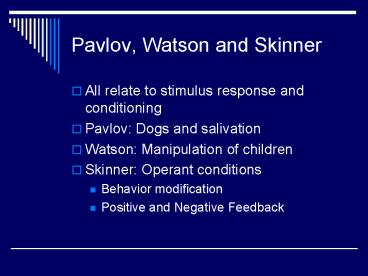Pavlov, Watson and Skinner - PowerPoint PPT Presentation
1 / 10
Title:
Pavlov, Watson and Skinner
Description:
Social mistrust demonstrated via ease of feeding, depth of sleep, ... Rough and Tumble. Games with Rules. Essay Question Hints. Define terms used in question ... – PowerPoint PPT presentation
Number of Views:577
Avg rating:3.0/5.0
Title: Pavlov, Watson and Skinner
1
Pavlov, Watson and Skinner
- All relate to stimulus response and conditioning
- Pavlov Dogs and salivation
- Watson Manipulation of children
- Skinner Operant conditions
- Behavior modification
- Positive and Negative Feedback
2
Erikson's Stages of Psychosocial Development
- Oral-sensory
- Muscular-anal
- Locomotor-genital
- Latency
- Adolescence
- Adulthood
- Maturity
3
Erikson's Oral-Sensory Stage
- Basic trust vs basic mistrust Hope
- Birth to 1 1/2 years
- Social mistrust demonstrated via ease of feeding,
depth of sleep, bowel relaxation - Depends on consistency and sameness of experience
provided by caretakeer - Second six-months teething and biting moves
infant "from getting to taking" - Weaning leads to "nostalgia for lost paradise"
- If basic trust is strong, child maintains hopeful
attitude
4
Erikson's Muscular-Anal Stage
- Autonomy vs. Shame and Doubt Will
- 1 1/2 year to 3 1/2 years
- Biologically includes learning to walk, feed
self, talk - Muscular maturation sets stage for "holding on
and letting go" - Need for outer control, firmness of caretaker
prior to development of autonomy - Shame occurs when child is overtly self-conscious
via negative exposure - Self-doubt can evolve if parents overly shame
child, e.g. about elimination
5
Erikson's Locomotor Genital Stage
- Initiative vs. Guilt Purpose3 1/2 to 6 years
- Initiative arises in relation to tasks for the
sake of activity, both motor and intellectual - Guilt may arise over goals contemplated
(especially aggressive) - Desire to mimic adult world involvement in
oedipal struggle leads to resolution via social
role identification. - Sibling rivalry frequent
- Willingness to take risks
- Sex differences in learning appear
6
Erikson's Latency Stage
- Industry v Inferiority Competence
- 6 to 11 years
- Child is busy building, creating, and
accomplishing - Receives systematic instruction as well as
fundamentals of technology - Danger of sense of inadequacy and inferiority if
child despairs of his tools/skills and status
among peers - Socially decisive age
7
Erikson's Adolescent Stage
- Identity v Role Confusion Fidelity
- 11 years and through end of adolescence
- Struggle to develop ego identity (sense of inner
sameness and continuity) - Preoccupation with appearance, hero worship and
ideology - Group identity (peers) develops
- Danger of role confusion, doubts about sexual and
vocational identity - Psychosocial moratorium, a stage between morality
learned by the child and the ethics to be
developed by the adult
8
Vygotsky and Bandura
- Vygotsky
- Knowledge constructed through culture
- Didactic process
- ZPD distance between childs actual and
potential performance - Scaffolding Temporary support system for
mediation of learning language and shared
activity and improvement of problem-solving
abilities
- Bandura
- Social Learning Theory
- Imitation of behavior
- Socialization
- Rehearsing as a tool for learning
9
Play
- Functional
- Constructive
- Pretend/Imaginative
- Rough and Tumble
- Games with Rules
10
Essay Question Hints
- Define terms used in question
- Identify applications of terms used in question
- Provide examples of terms used in question
- Provide classroom applications of terms used in
question































